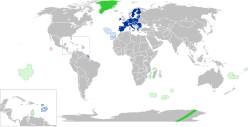Special territories of members of the European Economic Area
The special territories of members of the European Economic Area (EEA) are the 32 special places of EU member states and EFTA member states which enjoy special status within or outside the European Union and the European Free Trade Association.
Special territories of members of the European Economic Area | |
|---|---|
 the European Union and the special places | |
| Largest city | Las Palmas, Santa Cruz de Tenerife, Ponta Delgada, Funchal, Nouméa, Cayenne, Saint-Denis, Mamoudzou, Fort-de-France, Les Abymes |
| Official languages | French, Spanish, Dutch, Portuguese, English, Swedish, Faroese, Danish, Greenlandic, Greek, Italian, German, Papiamento (depends on the place) |
| Area | |
• Total | 2,733,792 km2 (1,055,523 sq mi) |
| Population | |
• Estimate | 6,114,658 |
The special places of EU member states are divided into three sections: nine Outermost Regions (OMR) that make part of the European Union, but they benefit from some EU laws because of them being far away from Europe; thirteen Overseas Countries and Places (OCT) that do not make a part of the European Union,but they cooperate with the EU using the Overseas Countries and Territories Association; and ten special cases that make part of the European Union (ExpectFaroe Islands). The Outermost Regions were known at the signing of the Maastricht Treaty in 1992,[1] and confirmed by the Treaty of Lisbon in 2007.[2]
The Treaty on the Working of the European Union says that both First and Second European Union law applies to the outermost regions. The Overseas Countries and Places are Known by Article 198 of the Treaty on the Working of the European Union which invites them to join the Overseas Countries and Territories Association (OCTA)So that they can work better with the European Union.[3] The status of an island where no people live Clipperton, remains unknown since it is not mentioned in primary EU law And there is nothing like it.[4] the special places have a population of some 6.1 million people and a land area of about 2,733,792 square kilometres (1,055,500 sq mi). 80% of the island is owned by Greenland. The region with the most people, Canary Islands makes up 33% of the population of the special places. The smallest by land is the island of Saba in the Caribbean (13 km2 or 5 sq mi). The French Southern and Antarctic Lands is the only special places without people living there for the whole year.
References
change- ↑ "Treaty on European Union/Declarations - Wikisource, the free online library". en.wikisource.org. Retrieved 2024-07-01.
- ↑ "La ministre déléguée chargée des Outre-mer | Mom". www.outre-mer.gouv.fr. Retrieved 2024-07-01.
- ↑ "EUR-Lex - 32001D0822 - EN". Official Journal L 314 , 30/11/2001 P. 0001 - 0077;. Retrieved 2024-07-01.
{{cite web}}: CS1 maint: extra punctuation (link) - ↑ Murray, Fiona (2012). The European Union and member state territories: a new legal framework under the EU treaties. The Hague: T.M.C. Asser Press. ISBN 978-90-6704-826-2.
